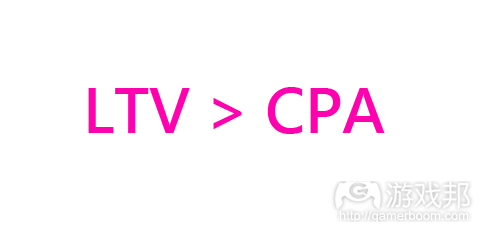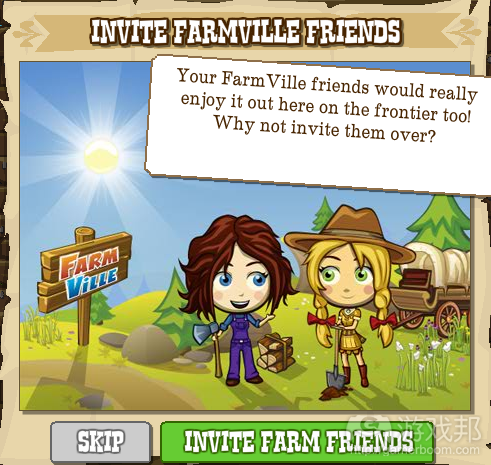从病毒式循环剖析社交游戏成功盈利的原因
我最近刚刚在Gamasutra上看到了一篇很棒的博文,探讨为何像《Farmville》和《Mafia Wars》之类的社交游戏并非真正社交化的原因。
“理解何谓‘社交游戏’这个词的含义也非常重要。多数游戏并不具有社交化。它们只是单人或者多人游戏,利用社交网络(游戏邦注:多数使用的是Facebook)作为吸引人的方式。将当今行业内所谓的‘社交游戏’描述成‘病毒游戏’还更准确。”
如果你认真发掘这些游戏所获得的成功,就会意识到为何Facebook能够创造令人不可思议的机会。Facebook为这些游戏提供了大量的支持,使其成功的条件更为切实可行。我们发现:
如果用户终生价值(LTV)大于获取用户的成本(CPA),那么游戏就会获得商业上的成功。
这便是所有社交游戏获得商业成功的基本公式。当你意识到为何Facebook上的传播使得这个领域如此受人喜欢,你就会看到其中有趣的一面。首先是用户终生价值(游戏邦注:下文简称“LTV”)。影响这项数据的有两个关键因素。首先是用户的留存率。要想赚到钱,你就必须让用户经常回到游戏中。Facebook上成功的社交游戏能够让15%的月活跃用户每天登录游戏。在特别成功的游戏中,这项数据可能达到30%。Facebook之所以能够如此成功地驱动高留存率,是因为该社交网络本身就能够吸引用户。Facebook在2010年2月已有将近450亿的月页面访问量,用户每月耗费的总时间达到270亿分钟,它已经成为多数网民的“网络之家”。作为社交游戏应用开发者,如果你能够将自己的游戏整合到Facebook的核心UI中,再加上诸如News Feeds和通知之类的交流方式,你就很有可能成倍地增加游戏的留存率,这比独立站点游戏的效果要好得多。当然,你需要的是能够吸引玩家的游戏。但是,和优秀的游戏可玩性同等重要的是,你的社交游戏需要良好地整合到Facebook的交流系统中。
LTV还与你的游戏盈利能力有关。优秀的社交游戏能够将1%到2%的月活跃用户转变为付费用户,这些人每月平均在游戏中花费20美元。这个转化率确实不高,但是由于Facebook的覆盖面如此之广,付费用户的数量的增长十分迅速。我想Facebook发布自有付费平台以简化购买过程能够也能够使LTV得到提升。
我估计,成功社交游戏的LTV介于0.4美元到0.5美元之间。如果你是个独立站点的话,这个数量的LTV完全难以维持游戏的运营,因为用户获取成本(游戏邦注:下文简称“CPA”)通常要比这个LTV高得多。但是在Facebook传播中,这个LTV明显高于CPA。Facebook上的营销成本确实很低。让Facebook上的营销如此高效的因素有以下两个:
1、付费营销非常便宜!
如果你想要在Facebook上为社交游戏做广告的话,目前有3个付费营销渠道。第一个是在其他拥有虚拟货币系统的社交游戏上。这些社交游戏允许你通过真正的付款(游戏邦注:使用信用卡和paypal等)或推广来购买虚拟商品。推广包括通过注册Netflix或信用卡等方法获得虚拟货币。当然,还有安装其他Facebook应用这种形式。你可以与这些游戏的公司合作,使用“推广墙”来做广告。在没有设定基础注册玩家数量目标的前提下,通常一款社交游戏需要为每个用户的安装支付0.25美元到0.4美元。必须注意的是,由此获得的用户质量可能并不好,因为他们这么做并不是出于对你的游戏感兴趣。但是,如果这些用户已经考虑过在社交游戏中付费购买虚拟商品,那么也可以说他们确实是有价值的顾客。
第二个付费营销渠道是Facebook应用广告网络。这些广告网络呈现许多发行商可以在他们的应用中做推广的广告清单。因为Facebook及其应用流量的爆炸性成长,这种广告服务的供应量比需求量大得多,因而价格很低廉。这种广告并非以物质来吸引玩家,而且呈现的是标准的广告。你也可以通过与这些广告网络合作来减少CPA,降低风险。用户每次安装成本可能高达0.7美元。
第三种付费营销渠道便是购买Facebook广告。这些就是你在登录Facebook时在右手边栏位上看到的广告。如果你没有重视Facebook广告平台的强大力量的话,你就失去了很多机会。这种广告的目标定位简直令人称奇。你可以将广告投放的目标定位在指定的用户群中。这种营销渠道的成本最高,但是CPA仍然只有1美元,而且如果执行恰当的话还可以更低。
如果社交游戏的LTV只有0.4美元,付费营销的CPA成本介于0.25美元至1美元之间,那么要如何确保游戏能够运营下去呢?此时,就是Facebook病毒性循环起作用的时刻。
2、Facebook病毒循环让CPA再次下降!
成功的社交游戏指导如何通过构建游戏中的物质刺激来影响Facebook上所有的病毒性营销渠道。让我们看看《Farmville》是如何利用Facebook的病毒循环。
1、如果你添加更多的“邻居”,也就是邀请你的好友,那么就能够扩展你的农场。
2、当你在游戏中“升级”时,游戏鼓励你发布Newsfeed,让所有好友都能够看到。
3、游戏不断提供虚拟礼品,你可以赠送给好友,吸引他们加入游戏。
这些只是部分促使用户与好友分享游戏的游戏机制。这些做法的主要好处在于,这些免费的营销能够让你的营销行为更加有效。游戏的病毒性营销可以用病毒系数来衡量。通过有效地使用Facebook病毒循环,有些社交游戏可以将CPA下降到0.1美元甚至更少。
现在,让我们再来看看这个行业中的经济状况:
如果用户终生价值大于用户获取成本的话,游戏就会获得商业上的成功。
根据我的估算:
LTV 0.4美元大于CPA 0.1美元,这简直是社交游戏的淘金时代。
而在这个社交游戏淘金时代里,游戏玩法或设计并没有发生大变革。唯一不同的地方在于,Facebook成为了允许游戏病毒性传播的系统。
将来会发生什么变化呢?这种传播的经济系统会发生改变。随着竞争加剧,CPA会逐渐增加。但是,社交游戏和应用的质量也会提升,盈利会变得更加高效。接下来数年之内,这个行业会有极大的成长。
游戏邦注:本文发稿于2010年2月12日,所涉时间、事件和数据均以此为准。(本文为游戏邦/gamerboom.com编译,如需转载请联系:游戏邦)
Social Games are Not Social. They should be called Viral Games.
I recently read a great blog post at Gamasutra that examined how social games like Farmville and Mafia Wars are not really social at all:
“It’s also important to understand something about ‘social games’: Most of them are not social. They tend to be single or multi-player games that use social networks (mostly Facebook) as an easy way to drive player adoption. What the industry is calling ‘social games’ are more accurately described as ‘viral games’.”
When you dig into the success of these games, you realize why Facebook has been such an incredible opportunity. Facebook offers incredible distribution for these games, making the formula for success much more viable. Let’s take a closer look:
If Life Time Value of a User > Cost per Acquisition then the game will be financially successful.
This is the basic formula for the financial success of any social game. The interesting part about it is when you realize why distribution on Facebook has made the economics so much more favorable. Let’s break down the components. The first is Life Time Value of a User (LTV). This is driven by 2 key factors. The first is retention of the users. In order to make money, you need to get that user coming back and coming back often. A successful social game on Facebook is able to get over 15% of their Monthly Active Users coming back each day. An extremely successful game gets that stat above 30%. Facebook is so successful at driving high retention because it already gets their users coming back. With over 27 billion minutes spent and nearly 45 billion page views per month, Facebook has quickly become for most people, their home on the Web. You add the fact that as a social game application developer you can integrate your game into the Facebook core UI with communication points such as News Feeds, notifications and wall posts, you have this incredible opportunity to increase your retention rates by folds versus what they would be as a standalone web site. Of course, you need a game that is also compelling to play. However as important as good game play, your social game needs to be well integrated into Facebook’s communication system.
Lifetime value of a user also depends on your ability to monetize game players. A good social game will convert about 1 to 2% of its Monthly Active Users to paid users who spend on average about $20 per month. It doesn’t sounds like a high conversion rate and it isn’t. However with such large scale from the massive distribution on Facebook, it can add up pretty quickly. I think one way that this may improve is when Facebook rolls out its own payment platform to streamline purchases as how Apple has done with apps on the Iphone.
I have estimated that the LTV of a fairly successful social game is somewhere around $.40 to $.50. That type of LTV is actually pretty hard to make work if you were a standalone web site because of the Cost per Acquisition of that user is usually significantly higher than the LTV. However in the case of Facebook distribution, the LTV is actually much higher than the incredibly low CPAs that can be found on Facebook. To be discussed in the next post.
So, in my previous post I went over Life Time Value (LTV) of a user of a social game and how the Facebook ecosystem dramatically improves it. However, this LTV is not exceptionally high given that only 1 to 2% of Monthly Active Users actually pay each month. LTV of a user for these games is only about $.40 which is actually low but the great thing about Facebook is that the marketing costs are so low and you can a ton of volume therefore you are able to scale. There are two factors that makes marketing so efficient on Facebook:
1. Paid Marketing is really Cheap!
So there are 3 paid marketing channels if you want to advertise your social game on Facebook. The first is on other social games that have a virtual currency system. These social games allows you to buy virtual goods either through actual payment (credit card, paypal, etc.) or through offers. Offers consists of getting virtual currency for actions such as signing up for Netflix or a credit card. It also consists of installing another Facebook application. You can advertise with companies that power these “offer walls” on a cost per acquisition basis. A social game without any targeting with a basic sign up would pay about $.25 to $.40 per install. Warning, these are incentivized offers and the quality of the users may not be that good given that they are not doing it primarily for the interest of your game. However, if they are already thinking about paying for virtual goods on a social game one could argue that this would actually be a very attractive customer.
Another paid marketing channel are Facebook application ad networks. These ad networks represent the ad inventory of many app publishers that serve up advertising within their app. Given the explosive growth in Facebook and app traffic, the supply of inventory is greatly larger than demand so this inventory is very cheap. This inventory is not incentivized and is served up as standard display ads. You can also cut CPA deals with these ad networks mitigating your risk. You should expect to pay about $.70 per install.
The third paid marketing channel is buying Facebook ads themselves. These are the ones that you see on the right hand column while you are on Facebook. If you haven’t seen the power of the Facebook ad platform, you are missing out. You can buy on a CPC basis and the level of targeting is amazing. Not only can you target by incredibly detailed demos but you can also base your targeting on specific psychographics whether it be interests and even more interesting if that person uses specific apps. This type of marketing may be the most costly but you can still achieve $1 CPA or less with good execution.
So if the LTV of a user of a social game is only $.40, how do you make the economics work since your CPA costs from paid marketing is between $.25 to $1? Well, this is when the Facebook Viral Loop kicks in.
2. Facebook Viral Loop Makes the CPA much better!
Successful social games know how to leverage all the viral marketing channels on Facebook by building incentives in the game. Let’s take a look at how Farmville uses the Facebook viral loops.
- If you add more “neighbors” which consists of inviting your friends, you get to expand your farm.
- As you “level up” in the game they prompt you to post to your Newsfeed for all your friends to see.
- They constantly offer virtual gifts that you can give to your friends in order for them to join.
These are just a few of the game mechanics to get users to share the game with their friends. The main benefit here is that this is free marketing that really makes your marketing efforts much more efficient. How well a game is at this viral marketing is measured and represented as a Viral Coefficient. By effectively using the Facebook viral loop, an effective social game can reduce their effective CPA cost down to $.10 or less.
So let’s recap on what the economics looks like:
If Life Time Value of a User > Cost per Acquisition then the game will be financially successful.
So based on my estimates:
$.40 LTV of a user > $.10 CPA of a user = SOCIAL GAME GOLD RUSH!
As you can see the Social Game Gold Rush has less to do with any real paradigm shifts in game play or design. Where the paradigm shift has happened is in Facebook being this incredible distribution system that allows the games to be viral.
What does the future entail? Well, the economics of this distribution will change. Cost per Acquisition will increase as it gets more competitive. However, the quality of social games and apps will improve and monetization will become more effective. This industry will be experience some serious growth over the next few years. (Source: Launchtime)









































 闽公网安备35020302001549号
闽公网安备35020302001549号